
Carlos Barria
Iranian Foreign Minister Mohammad Javad Zarif, center, Head of the Iranian Atomic Energy Organization Ali Akbar Salehi, left, and Hossein Fereydoon
The deal struck between Iran and world powers on Tuesday leaves big issues only semi-resolved. Even the date of the agreement's implementation hasn't been determined at the moment.
And interpreting the deal will be the responsibility of future US presidential administrations and the UN Security Council.
One of the keys to verifying the deal is ensuring that Iran isn't engaged in weaponization activities, research, and tests that would probably take place at military bases that are not considered "nuclear sites" as defined under the agreement.
Iran chafed at opening up its military sites to foreign inspectors, seeing this as an undue violation of their sovereignty and national security.
The compromise is "managed access," a mechanism that allows the
Managed access has to run smoothly for a deal to work. It gets to whether the international community can determine if Iran is engaging in nuclear weapons activities - and helps shape what the US and its partners can do if Iran seems to be in violation of its commitments.
With today's deal, we finally know how that managed access will work.
Basically, the deal allows for a specific and potentially robust means for the international community to work out disputes with Iran on weaponization work. The agreement is meant to work out disputes between Iran and the international community, and between the US and its various partners.
But the amount of time allowed to settle disputes is very significant.
Here's the key paragraph:

Russian Ministry of Foreign Affairs screenshot
Iran would then have three days to respond to the joint commission, leaving a 25-day period between a possible denial of access and an Iranian obligation to comply with a request.
The risk is that Iran could spend those 25 days scrubbing evidence of a violation from a suspicious site. And during those same 25 days, deep fissures could open up within the joint commission - and among the US and its allies - as to how the proceed in the face of potential Iranian intransigence.Is 25 days enough of a span of time to work out access disputes and determine a way forward? That depends on how the US and Iran implement and interpret Tuesday's deal. And it could be years before the sides reach a status quo.
Those 25 days could be enough to stop Iran from engaging in the kind of work that could help it go nuclear in future. Or it could be enough of a window to doom the deal entirely.
